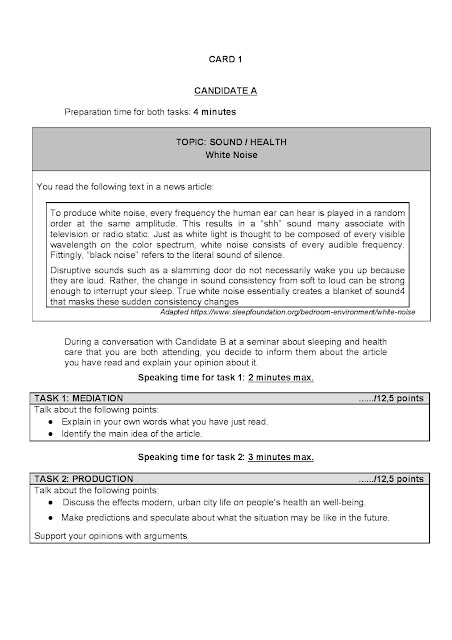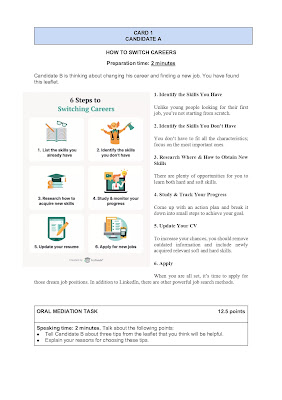MY HOUSE IS YOUR HOUSE
TIPO DE MEDIACIÓN:
-Oral y escrita
-Interlingüística (Español-Inglés)
-Informativa - Mediating texts (mediando textos)
-Subtipo: Translating a written text in speech / writing (traducir un texto oralmente / por escrito)
TIPO DE TEXTO Y ÁMBITO: Public - "rules or regulations"
NIVEL: C1 / C2
-Oral y escrita
-Interlingüística (Español-Inglés)
-Informativa - Mediating texts (mediando textos)
-Subtipo: Translating a written text in speech / writing (traducir un texto oralmente / por escrito)
TIPO DE TEXTO Y ÁMBITO: Public - "rules or regulations"
NIVEL: C1 / C2
DESCRIPTOR DEL CV: "Can provide fluent spoken translation into (Language B) of complex written texts written in (Language A) on a wide range of general and specialised topics, capturing most nuances"; "Can translate into (Language B) abstract texts on social, academic and professional subjects in his/her field written in (Language A), successfully conveying evaluative aspects and arguments, including many of the implications associated with them, though some expression may be over-influenced by the original."
En este caso: "Puede traducir oralmente y por escrito una carta referida a asuntos legales y de propiedades".
OBJETIVOS DE LA TAREA (RD):
-Traducir fragmentos, relevantes con respecto a actividades del propio interés en los ámbitos personal, académico o profesional, de textos escritos tales como correspondencia formal, informes, artículos o ensayos.
ESTRATEGIAS DE MEDIACIÓN:
a) Estrategias para explicar conceptos nuevos
-Adaptando el lenguaje: "Can explain technical terminology and difficult concepts when communicating with non-experts about matters within his/her field of specialisation" (explicar terminología técnica, en este caso referida a préstamos); "Can adapt his/her language (e.g. syntax, idiomaticity, jargon) in order to make a complex specialist topic accessible to recipients who are not familiar with it" (adaptar la explicación al horizonte cultural-mental de un adolescente medio).
-Simplificando información complicada: "Can facilitate understanding of a complex issue by highlighting and categorising the main points, presenting them in a logically connected pattern and reinforcing the message by repeating the key aspects in different ways" (destacar las ideas principales, conectándolas y repitiendo la información esencial de varias maneras).
b) Estrategias para simplificar el texto
-Amplificando un texto denso: "Can make the main points contained in a complex text more accessible to the target audience by adding redundancy, explaining and modifying style and register" (añadir redundancias, cambios de estilo y registro para hacer el texto accesible).
TEMPORALIZACIÓN: Para la primera parte (leer las instrucciones y los textos y hacer una traducción oral para el compañero, exponerla en turnos y tomar notas de la del compañero, y luego trabajar conjuntamente los textos para hacer una versión moderada por escrito), digamos sobre 20 -25 minutos. La segunda parte (hacer la traducción escrita y enviársela al docente) se haría fuera del horario lectivo.
DESENVOLVIMIENTO DE LA TAREA: Se organiza al alumnado en parejas. Cada uno recibirá una de las dos cartas del catastro que se incluyen más abajo, y tendrá que realizar una traducción oral de ella, mientras su compañero escucha y toma notas para evaluar su producción. Luego de haberse alternado, comentan los resultados de sus rúbricas y trabajan conjuntamente en mejorar la traducción para una versión definitiva por escrito, que completan en casa y reenvían al docente.
EVALUACIÓN DE LA TAREA: Coevaluación: mediante una rúbrica negociada previamente con el alumnado que incluya descriptores sobre fidelidad del texto, modificación y aclaración de términos técnicos, naturalidad del texto en la lengua B con respecto al texto original, etc... Heteroevaluación: del docente sobre el texto escrito empleando una rúbrica similar (o la misma) que en el caso previo; durante la parte oral, monitorizando a las parejas y dando retroalimentación holística. Real Decreto: "Aplica con soltura las estrategias adecuadas para adaptar los textos que debe procesar al propósito, la situación, los receptores y el canal de comunicación, sin alterar la información y las posturas originales".
TAREA
Contextualización: Matthew es tu vecino británico, que ha comprado una casa en tu villa en la que reside durante los veranos. Mientras está en el Reino Unido, tú eres el que comprueba la correspondencia de su buzón y le informas de ella. Hoy ha llegado la siguiente carta del catastro, y lo telefoneas para informarle.
Instrucciones:
Take a look at the corresponding letter that your British absent neighbor has received today (each of you consults a different one):
1) You phone your neighbor and friend Matthew to inform him of the contents of the letter you have just received. Over the telephone, he asks you to provide an informal translation of its contents. Make the translation.
(Tell it to your partner. While you are speaking, your partner will check the original text and take notes).
2) Listen to / give feedback to your partner using your rubric and notes.
3) The following day, Matthew calls you. After thanking you for your troubles, he requires as an additional favor that you send him a written translation of the letter, which he needs for his attorney and to satisfy his tax obligations in the UK. Make the translation.
(Using your partner's feedback, you can both work together on how to improve your respective texts; at home, finish the work, write the translation and e-mail it to the teacher).
NOTA: Leyendo los descriptores del CV, no me queda del todo claro si este tipo de traducción no pertenece más al nivel C2 que al C1. En todo caso, podrían hacerse de ser necesarias adaptaciones para encajarla en ambos niveles.
A mayores de la traducción, otra actividad complementaria sería la de explicar al vecino el funcionamiento del catastro y la conveniencia (o no) de reclamar la subida que se anuncia en las cartas (la subida es escalonada; si bien para el próximo ejercicio fiscal es menor, irá subiendo progresivamente hasta adecuarse a la nueva valoración catastral de la propiedad).






Comentarios
Publicar un comentario